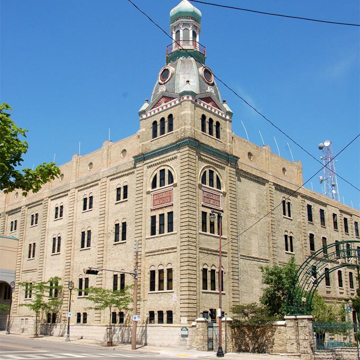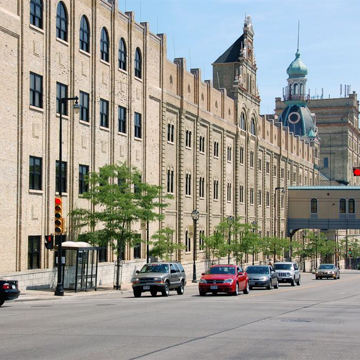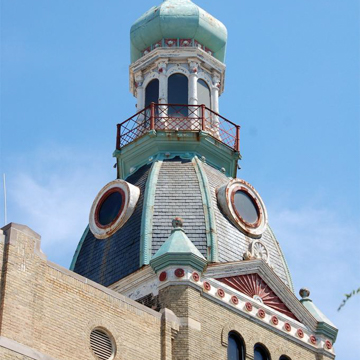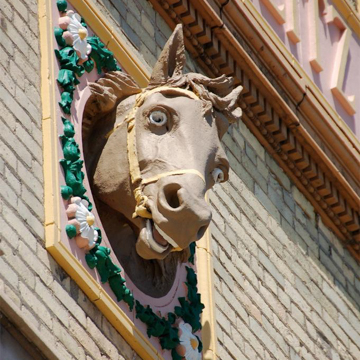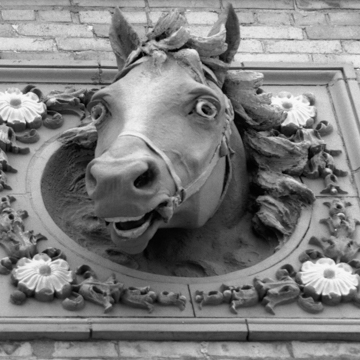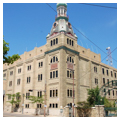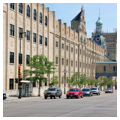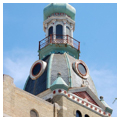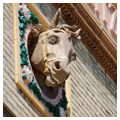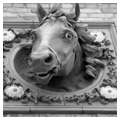You are here
Schlitz Business Park
Milwaukee became “Beertown” because brewers including the now-defunct Schlitz Brewing Company made it famous. Schlitz originated in 1849, when August Krug opened a brewery near the corner of 4th and Highland streets—one of many German-immigrant industrial ventures along the Milwaukee River. After Krug died in 1858, his bookkeeper, Joseph Schlitz, bought the business. In 1870 Schlitz created a larger brewery upriver at 3rd and Walnut streets. Success largely resulted from opportunistic marketing. After the Great Chicago Fire of 1871 Schlitz shipped beer there, winning Schlitz customers and thereby, legend claims, earning its slogan “The Beer That Made Milwaukee Famous.” Schlitz died in 1875, but his four nephews named Uihlein took control. By 1900 Schlitz was America’s third biggest brewery, and the nation’s largest in the 1940s. In the 1950s it pioneered a trend toward building new breweries and buying regional competitors, but labor troubles, quality-control problems, and marketing woes eroded the company’s position in the next decades. Though still America’s third largest brewer, Schlitz shut its flagship Milwaukee brewery in 1981 and sold out to Detroit’s Stroh the next year. The Schlitz and Uihlein names remain prominent in Milwaukee, and the Schlitz Brewing Company Complex, although partly demolished, still offers a glimpse of the industry.
The two-story cream brick building at 221–235 W. Galena Street originally served as the brewery office building; Milwaukee County offices now occupy part of it. The unimpressive exterior houses a faithfully reproduced German-style rathskeller inside that was built by Schlitz as a tourist-hospitality room in the 1930s. Today it is a restaurant.
The brewing process can be traced in the following buildings, starting in the Romanesque Revival brewhouse (1890) one door east of the rathskeller. Here massive copper kettles heated water and malted barley to produce wort, which was transferred to additional vessels to be boiled with hops. The staircases of the brewhouse’s soaring skylit interior are adorned with delightful ironwork, including balustrades with hop-flower motifs and newel caps in the shape of beer barrels.
From the brewhouse, the liquid wort was piped into stock houses for fermentation. The largest and sole surviving stock house stands at the northeast corner of King Drive and W. Galena Street, stretching almost the entire block north to Walnut. Completed in 1900, this massive structure housed rows of refrigerated tanks, where wort fermented with yeast to produce beer. Today it houses a junior high school. This stock house is the most eye-catching building left in the complex, with load-bearing cream brick walls, trimmed with limestone, sheet metal, and terra-cotta. German Renaissance Revival features include a stepped and scrolled gable on the King Drive facade, ornamented with a plaque depicting Schlitz’s trademark, and a stocky corner tower where a series of arched windows rise to four stein-cap domes bracketing sunburst pediments at the foot of an elongated slate-roofed hexagonal dome, which supports a dramatic lantern and its bulbous copper dome. Once fermented in the stock house, the finished beer was pumped into the bottling plant (1902) on the eastern edge of the complex at 1560 N. 2nd Street. Here beer was poured into bottles, cans, and kegs. Like the stock house, the bottling plant features Romanesque-arched windows and brick corbeling. Terra-cotta details, including foliated plaques and another belted globe, highlight a curiously flattened, stepped gable.
After packaging the beer, Schlitz employees delivered it. In the days before motorized trucks, Schlitz maintained a huge stable of horses and a fleet of wagons to haul its cases and kegs to every thirsty neighborhood in the city. The old stable, dating from 1896, is at the northwest corner of 2nd and Walnut streets. Even this utilitarian building shows some bold sculptural ornament. On the Walnut Street facade are lifelike terra-cotta horse heads, wild-eyed and champing at the bit.
Although Schlitz’s surviving buildings illustrate the brewing process, none survive to document the malting process. Trains would deliver barley to Schlitz’s massive grain elevators, the largest located at the northwest corner of 2nd and Cherry streets. Grain was transferred to a malt house on the east side of 3rd Street, between Cherry and Court streets. There, barley was soaked, germinated, and then roasted in a kiln before being funneled back to the brewhouse to begin the brewing process.
Writing Credits
If SAH Archipedia has been useful to you, please consider supporting it.
SAH Archipedia tells the story of the United States through its buildings, landscapes, and cities. This freely available resource empowers the public with authoritative knowledge that deepens their understanding and appreciation of the built environment. But the Society of Architectural Historians, which created SAH Archipedia with University of Virginia Press, needs your support to maintain the high-caliber research, writing, photography, cartography, editing, design, and programming that make SAH Archipedia a trusted online resource available to all who value the history of place, heritage tourism, and learning.





















